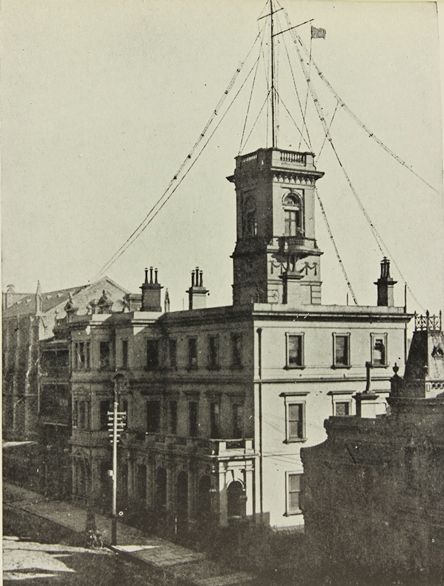
The ship, when safely under the land-batteries, was captured. It was hoped that the German captain, having been thus trapped, had not thrown overboard his secret codes and instructions. While placing the rest of the officers and crew under guard the captain was allowed more freedom than usual, in the hope that, thinking himself unwatched, he would attempt to destroy the secret documents and disclose their hiding-place. This in fact tuned out to be the case as in the early hours of the morning the German captain crept from his bunk, and, entering an inner cabin, slid back a panel behind which lay the papers. District Naval Officer, Captain Richardson, instantly covered him with a revolver and secured them. Amongst them was the code subsequently translated by Dr. Wheatley.However most of the work although important was far less exciting. In this case most of the duties revolved around patrols and maintaining dock defences. In Sydney this included the laying and the care of booms and nets as well as the provision of sentries and boat-patrols. About 500 people were engaged working for the naval brigade at Sydney whose work included: Examination Services; maintaining the Port War Signal Station; guarding Cockatoo Island, Spectacle Island, Garden Island, Gore Bay oil-tanks, Mort’s dock; managing the Pennant Hills wireless station, Woolwich dock, Admiralty House, Hawkesbury bridge, looking after interned enemy vessels and patrolling the Harbour.The sinking of the Cumberland off the coast of Australia in July, 1917, imposed on the naval brigade two new and extremely important duties. For some time the naval brigade was uncertain whether she had been sunk by the explosion of a bomb placed among her cargo or by collision with a mine and so precautions were taken against the recurrence of either danger. Initially preference was given to the bomb placed on board and as a result a Cabinet meeting was held which decided that the naval authorities should take over the duty of providing guards for all wharves and shipping, especially oversea shipping. The military who apparently had previously been attending to this duty were asked to supply the bulk of the guards but control of these was transferred to the navy.
The wireless stations of the Commonwealth were at the beginning of the war put in charge of the military but ttoward the end of 1916 the navy took over control of the principal stations at Townsville, Rockhampton, Brisbane, Sydney, and Adelaide. In February, 1917, a new regime was adopted at these stations which ensured a petty officer and four men were on duty night and day, with provision to increase this number in time of danger. In April it was decided to bring the guarding of the stations at Thursday Island, Cooktown, Melbourne, Hobart, and Perth under similar control. This left Darwin in control of the military and Port Moresby to the care of the local European constabulary, and the out-stations of Western Australia-Esperance on the Bight, Geraldton, Roebourne, Broome, and Wyndham-to night watchmen only.
The brigade at its moment of greatest expansion numbered 2,817 adults and 3,834 cadets. Many of these were at different times used for different services (a man being engaged, say, for six months in mine-sweeping, and three years in examination services), the enrolment by services shows a larger muster.
References
The Royal Australian Navy, Arthur W Jose, Angus and Robertson, Sydney, 1835
![]() Geoff Barker, Coordinator Collections and Research Services, Parramatta City Council Heritage Centre, 2014
Geoff Barker, Coordinator Collections and Research Services, Parramatta City Council Heritage Centre, 2014


